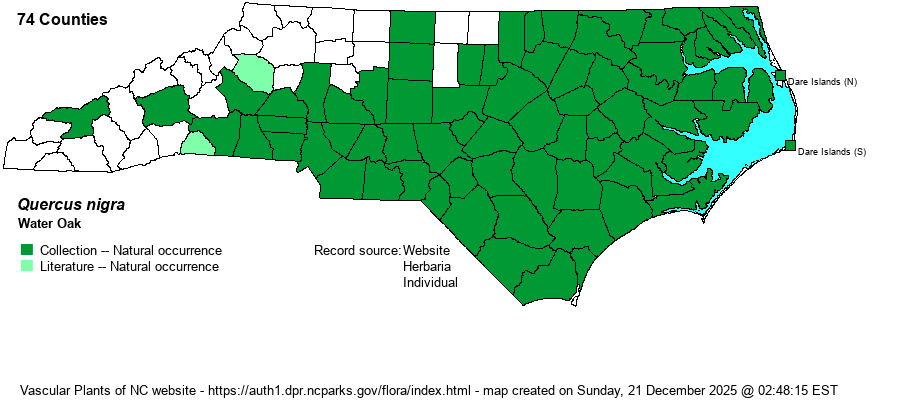| Author | L. | |
| Distribution | Throughout the Coastal Plain and most of the southwestern two-thirds of the Piedmont. Present in at least two Mountain counties (Buncombe and Swain) in the southern half of the province. Apparently absent from Piedmont counties west of Rockingham and north of Iredell and Caldwell -– i.e., the northwestern quarter of the province. The species is perhaps advancing slightly westward in recent years.
This Southern species ranges north only to southern NJ and southeastern MO, and south to southern FL and eastern TX. It is very rare in mountain regions.
| |
| Abundance | Common and widespread in the Coastal Plain and the southeastern third of the Piedmont. Fairly common in the central Piedmont, but rare in the remainder of the Piedmont and the southern Mountains. | |
| Habitat | This is primarily a bottomland forest species, mainly in brownwater floodplains, but it does occur in blackwater systems. Over the last few decades, however, it has greatly spread into mesic upland situations, especially in fire-suppressed sites. Former Longleaf Pine (Pinus palustris) sandhills are now becoming Loblolly Pine (P. taeda) dominated, owing to fire suppression, with Water Oak often a subcanopy tree. In the Piedmont and much of the northern Coastal Plain, it often grows as a successional tree where Loblolly Pine dominates. |
| Phenology | Flowers in April, and fruits from September to November of the following year. | |
| Identification | This is a quite familiar medium deciduous tree, usually reaching about 80 feet tall, rarely to 100 feet (and then essentially in bottomlands). It is usually easily identified by its “unique” leaves -– narrowly paddle-shaped or top-shaped, with the distal end greatly rounded. Some leaves may have single broad lobes on each side near the apex, and thus appearing to have three rounded lobes. Though it is a “red oak” species, requiring about 1.5 years for acorns to mature, bristle tips on the leaves are not obvious. However, note that young leaves, or leaves on saplings, can have odd shapes, with additional rounded lobes; a few other oaks can also have leaves somewhat like Water Oak when young. You may need to look at leaves on the upper half of the tree to be sure. | |
| Taxonomic Comments | None
| |
| Other Common Name(s) | Paddle Oak (very rarely used) | |
| State Rank | S5 | |
| Global Rank | G5 | |
| State Status | | |
| US Status | | |
| USACE-agcp | FAC link |
| USACE-emp | FAC link |

